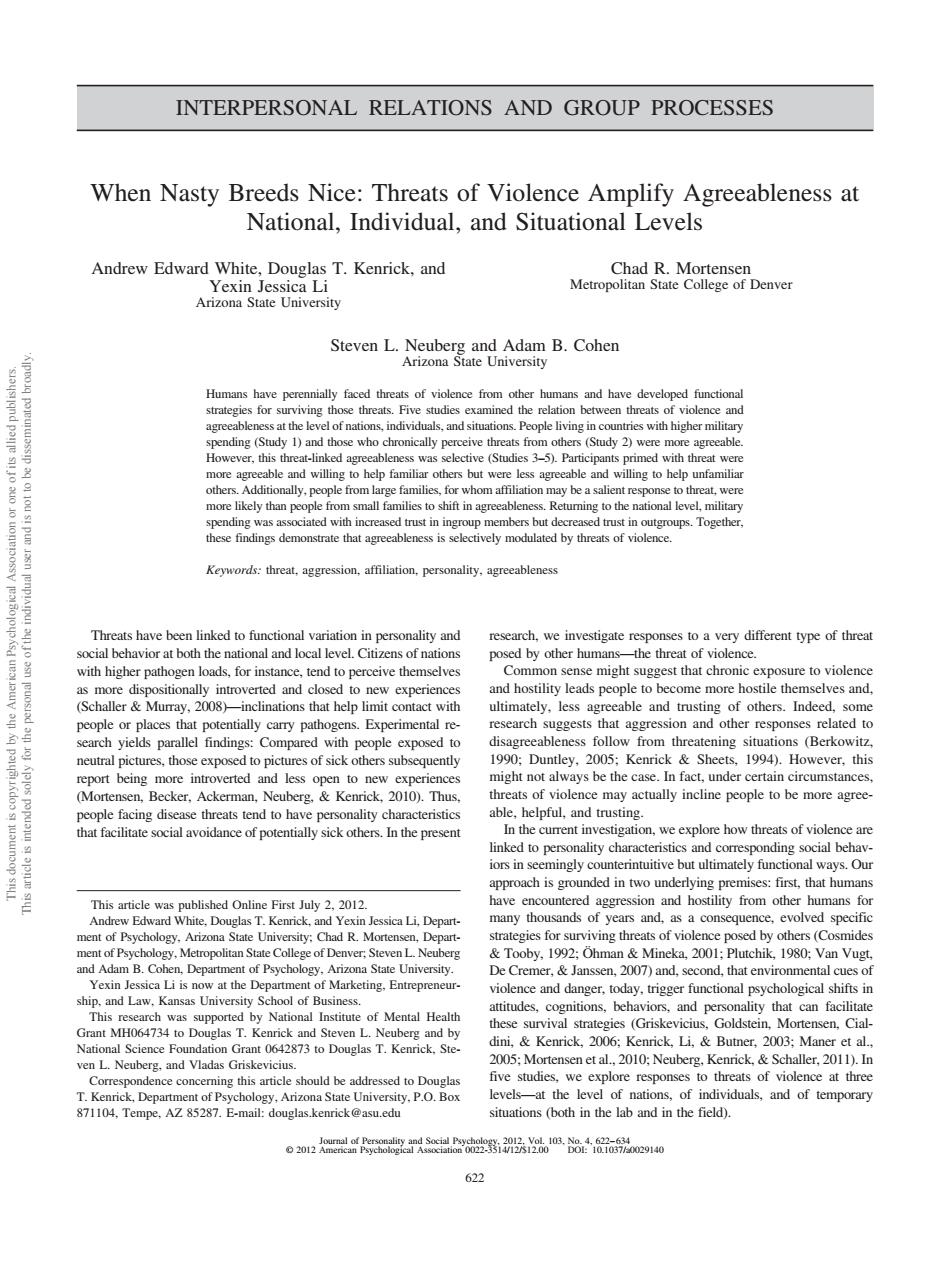正在加载图片...

INTERPERSONAL RELATIONS AND GROUP PROCESSES When Nasty Breeds Nice:Threats of Violence Amplify Agreeableness at National,Individual,and Situational Levels Andrew Edward White,Douglas T.Kenrick,and Steven L NbeB.Cohen 2ee were le ore likel y than Keywords:threat,aggression,affiliation,personality,agreeableness Threats have been linked to functional variation in personality and research.we investigate responses to a very different type of threat posed by other huma 200s help limit tions (Berkowit ht In fa 19).However,thi sen.Becker.Ackerman.Neubers Kenrick.2010).Thus reats of violence may actually incline people to be more agree rach is grounded in two underlving premises:first.that humans This article was published Online First July 2.2012. aggression ard White.Do CRMap s of viole sedby others (Co Tooby. 2000 chik,1980:Van Vug eting.Entreprene and danger.today.functional in 622INTERPERSONAL RELATIONS AND GROUP PROCESSES When Nasty Breeds Nice: Threats of Violence Amplify Agreeableness at National, Individual, and Situational Levels Andrew Edward White, Douglas T. Kenrick, and Yexin Jessica Li Arizona State University Chad R. Mortensen Metropolitan State College of Denver Steven L. Neuberg and Adam B. Cohen Arizona State University Humans have perennially faced threats of violence from other humans and have developed functional strategies for surviving those threats. Five studies examined the relation between threats of violence and agreeableness at the level of nations, individuals, and situations. People living in countries with higher military spending (Study 1) and those who chronically perceive threats from others (Study 2) were more agreeable. However, this threat-linked agreeableness was selective (Studies 3–5). Participants primed with threat were more agreeable and willing to help familiar others but were less agreeable and willing to help unfamiliar others. Additionally, people from large families, for whom affiliation may be a salient response to threat, were more likely than people from small families to shift in agreeableness. Returning to the national level, military spending was associated with increased trust in ingroup members but decreased trust in outgroups. Together, these findings demonstrate that agreeableness is selectively modulated by threats of violence. Keywords: threat, aggression, affiliation, personality, agreeableness Threats have been linked to functional variation in personality and social behavior at both the national and local level. Citizens of nations with higher pathogen loads, for instance, tend to perceive themselves as more dispositionally introverted and closed to new experiences (Schaller & Murray, 2008)—inclinations that help limit contact with people or places that potentially carry pathogens. Experimental research yields parallel findings: Compared with people exposed to neutral pictures, those exposed to pictures of sick others subsequently report being more introverted and less open to new experiences (Mortensen, Becker, Ackerman, Neuberg, & Kenrick, 2010). Thus, people facing disease threats tend to have personality characteristics that facilitate social avoidance of potentially sick others. In the present research, we investigate responses to a very different type of threat posed by other humans—the threat of violence. Common sense might suggest that chronic exposure to violence and hostility leads people to become more hostile themselves and, ultimately, less agreeable and trusting of others. Indeed, some research suggests that aggression and other responses related to disagreeableness follow from threatening situations (Berkowitz, 1990; Duntley, 2005; Kenrick & Sheets, 1994). However, this might not always be the case. In fact, under certain circumstances, threats of violence may actually incline people to be more agreeable, helpful, and trusting. In the current investigation, we explore how threats of violence are linked to personality characteristics and corresponding social behaviors in seemingly counterintuitive but ultimately functional ways. Our approach is grounded in two underlying premises: first, that humans have encountered aggression and hostility from other humans for many thousands of years and, as a consequence, evolved specific strategies for surviving threats of violence posed by others (Cosmides & Tooby, 1992; Öhman & Mineka, 2001; Plutchik, 1980; Van Vugt, De Cremer, & Janssen, 2007) and, second, that environmental cues of violence and danger, today, trigger functional psychological shifts in attitudes, cognitions, behaviors, and personality that can facilitate these survival strategies (Griskevicius, Goldstein, Mortensen, Cialdini, & Kenrick, 2006; Kenrick, Li, & Butner, 2003; Maner et al., 2005; Mortensen et al., 2010; Neuberg, Kenrick, & Schaller, 2011). In five studies, we explore responses to threats of violence at three levels—at the level of nations, of individuals, and of temporary situations (both in the lab and in the field). This article was published Online First July 2, 2012. Andrew Edward White, Douglas T. Kenrick, and Yexin Jessica Li, Department of Psychology, Arizona State University; Chad R. Mortensen, Department of Psychology, Metropolitan State College of Denver; Steven L. Neuberg and Adam B. Cohen, Department of Psychology, Arizona State University. Yexin Jessica Li is now at the Department of Marketing, Entrepreneurship, and Law, Kansas University School of Business. This research was supported by National Institute of Mental Health Grant MH064734 to Douglas T. Kenrick and Steven L. Neuberg and by National Science Foundation Grant 0642873 to Douglas T. Kenrick, Steven L. Neuberg, and Vladas Griskevicius. Correspondence concerning this article should be addressed to Douglas T. Kenrick, Department of Psychology, Arizona State University, P.O. Box 871104, Tempe, AZ 85287. E-mail: douglas.kenrick@asu.edu Journal of Personality and Social Psychology, 2012, Vol. 103, No. 4, 622– 634 © 2012 American Psychological Association 0022-3514/12/$12.00 DOI: 10.1037/a0029140 622 This document is copyrighted by the American Psychological Association or one of its allied publishers. This article is intended solely for the personal use of the individual user and is not to be disseminated broadly